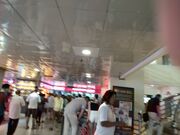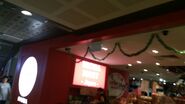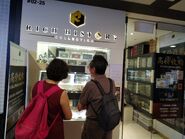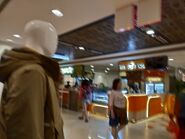Singapore's Chinatown is an ethnic neighbourhood featuring distinctly Chinese cultural elements and a historically concentrated ethnic Chinese population. Chinatown is located within the larger district of Outram.

People's Park Centre
As the largest ethnic group in Singapore is Chinese, Chinatown is considerably less of an enclave than it once was. (Note: The name Chinatown is given by the British and today usually used by non-Chinese Singaporeans, whereas Chinese Singaporeans usually use the term Niu Che Shui as the term Chinatown usually refers to enclaves of Chinese people in regions where Chinese people are the minority ethnic group.) However, the district does retain significant historical and cultural significance. Large sections of it have been declared national heritage sites officially designated for conservation by the Urban Redevelopment Authority.
Geography[]
Singapore's Chinatown is composed of several precincts - Kreta Ayer, Telok Ayer, Tanjong Pagar, Bukit Pasoh and Ann Siang Hill.
- Kreta Ayer - Kreta Ayer (meaning "water cart" similar to the Chinese name of "Niu Che Shui"; would be spelled "kereta air" in modern Malay) is considered by many to be the heart of Singapore's Chinatown. Housing attractions such as Chinatown Heritage Centre, Chinatown Food Street and Chinatown Night Market, and Kreta Ayer Wet Market.[1] Kreta Ayer is both a popular tourist destination as well as a favoured location for local food.
- Telok Ayer - The original focal point of settlement in Chinatown, Telok Ayer is home to many Chinese temples as well as Muslim mosques that have been around since the first days of Chinatown. More recently, restaurants and drinking holes have begun popping up on Telok Ayer's streets.
- Tanjong Pagar - Once the center of operations for rickshaw pullers, Tanjong Pagar today is known for the large number of bridal saloons that have set up shop along her rows of preserved pre-World War II shophouses. Singapore's tallest Housing and Development Board (HDB) flat, The Pinnacle@Duxton, also resides in Tanjong Pagar.
- Bukit Pasoh - Known also as the "Street of Clans", Bukit Pasoh is the historic, and in many cases, current, home of several Chinese cultural and clan associations - unusual neighbours to the slew of boutique hotels and international restaurants that have sprung up.
- Ann Siang Hill - Named after a wealthy Hokkien Chinese sawmiller who acquired the area to serve as his house and estate in the 1800s, the slopes of Ann Siang Hill are today filled with quirky shops, cafes and drinking holes, making it a popular hangout spot with the younger generation.
Chinatown Heritage Centre is a heritage centre that is located to symbolise the Chinese heritage, part of YourStudent. It was introduced in February 2007.
Hong Lim Park[]
Hong Lim Park (Template:Zh) is a Template:Convert heritage park in Singapore that is "the only venue in Singapore where public protests are allowed". It was selected by the government as the venue for Speakers' Corner in September 2000. Since then, it is the only place in Singapore where one can legally stage public protests. In early 2013, two protests against the government's immigration policies each drew more than 350 people, and in June 2014, about 20 people protested the Central Provident Fund (CPF), Singapore's state-run pension fund.
Etymology[]
The name Chinatown was used by the British while the locals went by these names: In Chinese, Singapore's Chinatown is known as Niu che shui (Template:Zh) as a result of the fact that, because of its location, Chinatown's water supply was principally transported by animal-driven carts in the 19th century. The name is also echoed in the Malay name, Kreta Ayer, with the same meaning.
Street name origins[]
- Mosque Street is named after Jamae Mosque, located on the South Bridge Road end of the street. The mosque was completed in 1830 by the Chulia Muslims from the Coromandel coast of South India but also used by the Malay Muslims living in the area. In the early years, Mosque Street was the site of ten stables.
- Pagoda Street takes its name from the Sri Mariamman Temple. During the 1850s and 1880s, the street was one of the centres of slave traffic. It also had its share of coolie quarters and opium smoking dens. One of the traders was Kwong Hup Yuen who, it is thought, occupied No. 37, and after whom Pagoda Street is often referred to today.
- Sago Lane and Sago Street got their name because in the 1840s there were a number of sago factories located there. Sago is taken from the pith of the rumbia palm and made into flour that is used for making cakes both sweet and savoury.
- Smith Street was probably named after Sir Cecil Clementi Smith, who was the Governor of the Straits Settlements between 1887 and 1893.
- Temple Street refers to the Sri Mariamman Temple, which is located at the South Bridge Road end of the street. It was formerly known as Almeida Street after Joaquim d'Almeida, son of José D'Almeida, who owned some land at the junction of Temple Street and Trengganu Street. In 1908, the Municipal Commissioners changed its name to Temple Street to avoid confusion with other streets in Singapore which were also named after D'Almeida.
- Trengganu Street, described as "the Piccadilly of Chinese Singapore" in the past, now forms the heart of the tourist belt in Chinatown. In Chinese, it is called gu chia chui wah koi, or "the cross street of Kreta Ayer". The crossing of streets refers to Smith Street and Sago streets. The street name is derived from Terengganu, a state in present day Peninsular Malaysia.
Teo Hong Road (Chinese: 赵芳路) is a one-way road located in the Tanjong Pagar area within the Outram Planning Area of Singapore. The road links Bukit Pasoh Road to New Bridge Road, and is lined with a row of conserved shophouses, built during colonial times. The conservation area is part of the Bukit Pasoh Conservation Area. The road was named after a Lam Ann carpenter, known as Teo Hong. He came to Singapore to become a building contractor. Among some of his projects, significant landmarks such as The Fullerton Singapore at Collyer Quay and the Old Ministry of Labour Building at Havelock Road. Teo Hong also owned pineapple plantations in Jurong and donated towards schools for his countrymen in the district.
Bukit Pasoh Road (Chinese: 武吉巴梳路) is a road in Tanjong Pagar within the Outram Planning Area of Singapore. The road starts from Neil Road which is one way, but becomes two ways, when the road forks out into two parts, with one becoming Teo Hong Road, with both roads ending at New Bridge Road. The road is mainly lined with conserved shophouses and houses a high-end boutique hotel known as the New Majestic Hotel. The place got its name from the Ali Baba jars, the tong or pasoh used to store rice or water in homes. There were many kilns in the 19th century that made these pots, bricks and tiles in Telok Blangah, Silat and Bukit Merah. A part of Bukit Merah was known as Brickworks in the past, due to the number of brick factories in that area. This road is located on the hill that in the 1830s marked the western boundary of the colonial town. Pasoh is the Malay word for "flower pot", and this was where earthenware pots used to be made. The hill has been renamed several times. It was first called Ryan's Hill from 1835 to 1836 after an early planter, Charles Ryan, who was the first owner of the hill as well as the first civilian Post Master of Singapore. It was sold to Hugh Syme in 1827 when Ryan returned to England; Syme renamed it Duxton Hill. It was bought by Dr Montgomerie in 1836 and developed into a nutmeg plantation together with nearby Craig Hill. Both were auctioned off in 1856 when Montgomerie died and fragmented it into building lots. The hill was later renamed Dickenson's Hill after Rev J.T. Dickenson, followed by Bukit Padre and finally Bukit Pasoh. Bukit Pasoh was owned by an opium farmer, Tan Keng Hoon, at the time of his death in 1877.
The road and its vicinity is a conservation area known as Bukit Pasoh Conservation Area, which is bounded by New Bridge Road, Keong Saik Road, Kreta Ayer Road, Neil Road and Cantonment Road. This area was given the conservation area status on 7 July 1989. The shophouses mainly consist of two and three storey shophouses in transitional, late and art deco styles.
History[]
Wang Dayuan visited Singapore (then called Temasek or Dan Ma Xi) in 1330 and recorded that there was a Chinese community. This would make Singapore one of the oldest Chinatowns, as well as the largest.
Under the Raffles Plan of Singapore, the area originally was a division of colonial Singapore where Chinese immigrants tended to reside. Although as Singapore grew, Chinese immigrants settled in other areas of the island-city, Chinatown became overcrowded within decades of Singapore's founding in 1819 and remained such until many residents were relocated at the initiation of Singapore's governmental Housing Development Board in the 1960s.
In 1822, Sir Stamford Raffles wrote to Captain C.E. Davis, President of the Town Committee, and George Bonham and Alex L. Johnson, Esquires, and members, charging them with the task of "suggesting and carrying into effect such arrangements on this head, as may on the whole be most conducive to the comfort and security of the different classes of inhabitants and the general interests and welfare of the place..."
He went on to issue instructions, as a guide to the Committee, which included a description of Singapore Town generally, the ground reserved by the government, the European town and principal mercantile establishments and the native divisions and "kampongs". These included areas for Bugis, Arabs, Marine Yard, Chulias, Malays, Markets and Chinese Kampongs, the present-day Chinatown. Raffles was very clear in his instructions and his guidelines were to determine the urban structure of all subsequent development. The "five-foot way", for example, the continuous covered passage on either side of the street, was one of the public requirements.
Raffles foresaw the fact that "it may be presumed that they (the Chinese) will always form by far the largest portion of the community". For this reason, he appropriated all of the land southwest of the Singapore River for their accommodation but, at the same time, insisted that the different classes and the different provinces be concentrated in their separate quarters and that these quarters, in the event of fire, be constructed of masonry with tiled roofs.
This thus resulted in the formation of a distinct section titled Chinatown. However, only when parcels of land were leased or granted to the public in and after 1843 for the building of houses and shophouses, did Chinatown's physical development truly begin.
The effects of diversity of Chinatown are still present. The Hokkiens (Fukiens) are associated with Havelock Road, Telok Ayer Street, China Street and Chulia Street, and the Teochew merchants are mostly in Circular Road, River Valley Road, Boat Quay and South Bridge Road. The ubiquitous Cantonese are scattered around South Bridge Road, Upper Cross Street, New Bridge Road and Bukit Pasoh Road. These days, the Hokkiens and Teochews have largely scattered to other parts of the island, leaving the Cantonese as the dominant dialect group in Chinatown.
The Chinese names hello Pickering Street and the Chinese call it Kian Keng Khau (mouth of the gambling houses) or Ngo Tai Tiahn Hok Kiong Khau (mouth of the five generations of the Tian Hok Temple).
Guilds, clans, trade unions and associations were all referred to as kongsi, a kind of Chinese mafia, although the literal meaning of the word is "to share". The so-called mafia is better translated as the secret and sinister hui. However, these secret societies, the triads, who themselves had suffered under the Manchus in China, provided support to the later immigrants to Singapore by paying their passage and permitting to pay it off by working.
There were the letter writers of Sago Street—the Chinese called this street Gu Chia Chwi Hi Hng Cheng (front of Kreta Ayer Theatre), but it was mainly associated with death—the sandalwood idols of Club Street and the complicated and simple food of Mosque Street; all rang to the sound of the abacus. Old women could be seen early in the mornings topping and tailing bean sprouts, the skins of frogs being peeled, the newly killed snakes being skinned and the centuries-old panaceas being dispensed by women blessed with the power of curing.
Surprisingly, in the heart of this diverse Chinese community is the most important temple for Singaporean Indians, the Sri Mariamman Hindu Tamil Temple, and mosques, Al-Abrar Mosque at Telok Ayer Street and Jamae Mosque at Mosque Street, as well as the Fukien Thian Hock Keng Chinese Temple of 1830 to 1842. These catered to the pockets of non-Chinese residents in the area and shows that despite efforts to segregate the early immigrants, they had no qualms living together, and side by side.
Architecture[]
The street architecture of Chinatown's buildings, the shophouses especially, combine different elements of baroque architecture and Victorian architecture and do not have a single classification. Many of them were built in the style of painted ladies, and have been restored in that fashion. These styles result in a variety of different colours of which pastel is most dominant. Trengganu Street, Pagoda Street and Temple Street are such examples of this architecture, as well as development in Upper Cross Street and the houses in Club Street. Boat Quay was once a slave market along the Singapore River, Boat Quay has the most mixed-style shophouses on the island.
In 1843, when land titles were issued, the terraces in Pagoda Street (now with additions, mostly three-story) were born. They were originally back to back, an arrangement which made night soil collection difficult, but lanes were developed in between following the Singapore Improvement Trust (SIT) backlane orders of 1935.
The architectural character of many of the terraces in Chinatown is much more Italianate in style than those of, for instance Emerald Hill or Petain Road. Windows often appear as mere slits with narrow timber jalousies (often with adjustable slats). Fanlights over the windows are usually quite decorative and the pilasters and balconies and even the plasterwork and colours seem to be Mediterranean in flavour. The style was probably introduced by those early Chinese immigrants (both China-born and Straits-born) who had knowledge of the Portuguese architecture of Macau, Malacca and Goa. The Chettiars and Tamils from Southern India would also have been familiar with the European architecture there, although it is difficult to imagine how these people would have had a particularly strong influence on building in Chinatown.
Transportation[]
Chinatown has a Mass Rapid Transit (MRT) station, called the Chinatown MRT Station on the North East Line and the Downtown Line, in the middle of Pagoda Street (which is closed to traffic) and serves the vicinity, as well as several public bus routes which integrates it into Singapore's transportation system. Also nearby are the Tanjong Pagar station on the East West Line, Outram Park Interchange which serves as an interchange between the East West Line and North East Line, and Clarke Quay station on the North East Line.
Since 11 May 2018, Chinatown also acts as a transfer point by providing shops in the People's Park Centre, from bus services to the MRT, of which it is Downtown Line.
Kreta Ayer Road[]
Kreta Ayer Road (Chinese: 水车路) is a one-way road located in Chinatown within the Outram Planning Area in Singapore. The road links Neil Road to New Bridge Road and Eu Tong Sen Street, and is intersected by Keong Saik Road.
Etymology and history[]
In the olden days, water drawn from a well near Ann Siang Hill was taken down in bullock carts, hence the name Kreta Ayer, which means "water cart road" in Malay. The Hokkiens refer to this area as gu chia chui, and the Cantonese call it ngow chay shui also meaning "bullock water cart road". Kreta Ayer Road was officially conferred in 1922.
Kreta Ayer Road defines for the Chinese in Singapore, the Chinatown area. For the Chinese, the Chinatown area is referred also as tua poh or "greater town" district. In the 1880s, Kreta Ayer was the red light district of Chinatown. The Chinese traveller, Li Zhongjue, observed in 1887 that the street was a place of restaurants, theatres and brothels and where "filth and dirt are hidden".
Chinatown Point[]
Chinatown Point is a shopping mall located in Chinatown, Singapore. It is a mixed development which includes a 25-storey office tower located right above the mall. Constructed in the 1990s, the mall opened in 1993. From 2011 to 2012, the mall underwent renovations after a change in the management. It held its soft core launch in 18 November 2012 and was fully operational in the 2nd quarter of 2013.[2] It had various outlets likewise Daiso, NTUC FairPrice, Cortina Watch, Design & Comfort and Genki Sushi.
Vincci is a shoe company in Malaysia, of which it had imported to Singapore for quite some time. In Thailand, it is also called "VNC Shoes". It has been there since 2008, and the only shop that is under Vincci in Singapore is at Chinatown Point. Vincci sells black and gold flats in 2008, and later on evolved with black high heels (cross strap) in Chinese New Year 2012.
History[]
When it first opened, the mall was at the forefront of shopping in Singapore. There were countless curio shops, pawn shops and jewelry stores. Like many old malls in Singapore, the shopping centre declined in popularity when newer malls opened within the region.[3]
In July 2010, the mall was bought over from City Developments Limited by Perennial (Singapore) Retail Management for S$250 million. The mall then underwent a S$90 million makeover from 2011 to 2012 which increased its total retail floor area by 18 percent.[4]
Other shopping centres[]

People's Park Centre, where there is Singapore Pools and remittance centres.
Other shopping centres include People's Park Centre and People's Park Complex.
Gallery[]
References[]
- Norman Edwards, Peter Keys (1996), Singapore - A Guide to Buildings, Streets, Places, Times Books International, ISBN 9971-65-231-5
- Victor R Savage, Brenda S A Yeoh (2003), Toponymics - A Study of Singapore Street Names, Eastern Universities Press, ISBN 981-210-205-1
External links[]
Template:Library resources box
- Official Singapore Chinatown website
- Chinatown Heritage Centre
- Template:Wikivoyage-inline
- Kreta Ayer on Visitsingapore.com
- 360° X 360° interactive VR of Chinatown
- Chinatownology: Singapore Chinatown
- Kreta Ayer Community Centre website
- The Streets of Chinatown from Think Singapore
- Living Wellness @ Chinatown Pagoda Street
Template:Roads and streets in Chinatown, Singapore
| {{{header}}} |
|---|
| {{{body}}} |
Template:China Town
Template:Coord

















